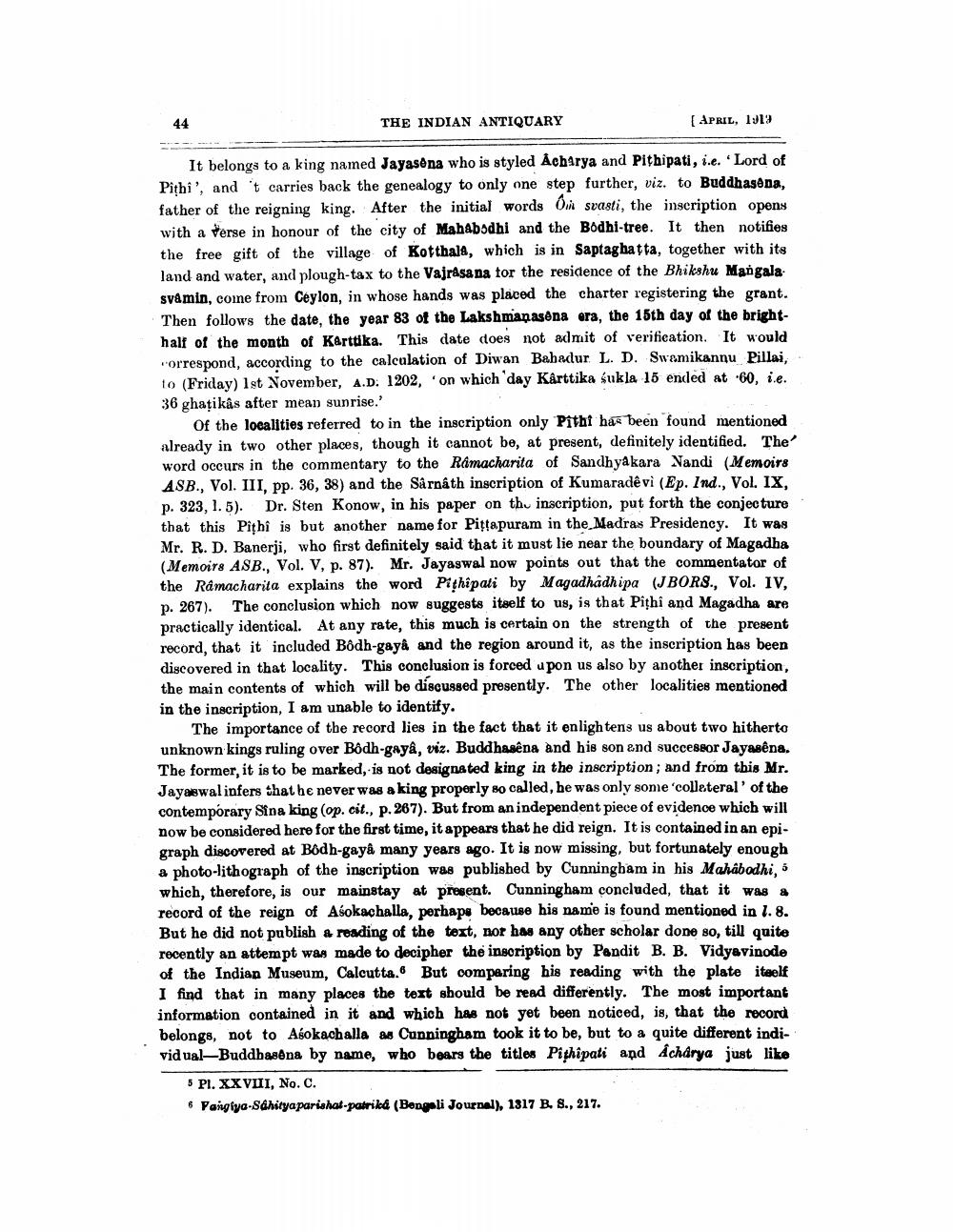________________
44
THE INDIAN ANTIQUARY
(APRIL, 1919
It belongs to a king named Jayasona who is styled Acharya and Pithipati, i.e. Lord of Pithi', and 't carries back the genealogy to only one step further, viz. to Buddhasena, father of the reigning king. After the initial words Oni svasti, the inscription opens with a terse in honour of the city of Mahabodhi and the Bodhi-tree. It then notifies the free gift of the village of Kotthala, which is in Saptag hatta, together with its land and water, and plough-tax to the Vajrasa na tor the residence of the Bhikshu Mangala svamin, come from Ceylon, in whose hands was placed the charter registering the grant. Then follows the date, the year 83 of the Lakshmanasena era, the 15th day of the brighthalf of the month of Karttika. This date does not admit of verification. It would Forrespond, according to the calculation of Diwan Bahadur L. D. Swamikannu Pillai, to (Friday) 1st November, A.D. 1202, 'on which day Karttika sukla 15 ended at 60. ie. 36 ghatikâs after mean sunrise.
Of the localities referred to in the inscription only Pithi has been found mentioned already in two other places, though it cannot be, at present, definitely identified. The word occurs in the commentary to the Ramacharita of Sandhyakara Nandi (Memoirs ASB., Vol. III, pp. 36, 38) and the Sårnáth inscription of Kumaradêvi (Ep. Ind., Vol. IX, p. 323, 1.5). Dr. Sten Konow, in his paper on thu inscription, put forth the conjecture that this Pithi is but another name for Pittapuram in the Madras Presidency. It was Mr. R. D. Banerji, who first definitely said that it must lie near the boundary of Magadha (Memoirs ASB., Vol. V, p. 87). Mr. Jayaswal now points out that the commentator of the Ramacharita explains the word Pithipati by Magadhadhipa (JBORS., Vol. IV, p. 267). The conclusion which now suggests itself to us, is that Pithi and Magadha are practically identical. At any rate, this much is certain on the strength of the present record, that it included Bôdh-gayâ and the region around it, as the inscription has been discovered in that locality. This conclusion is forced upon us also by another inscription, the main contents of which will be discussed presently. The other localities mentioned in the inscription, I am unable to identify.
The importance of the record lies in the fact that it enlightens us about two hitherto unknown kings ruling over Bôdh-gayâ, viz. Buddhasêna and his son and successor Jayasena. The former, it is to be marked, is not designated king in the inscription, and from this Mr. Jayaswalinfers that he never was a king properly so called, he was only some collateral' of the contemporary Sina king (op. cit., p. 267). But from an independent piece of evidence which will now be considered here for the first time, it appears that he did reign. It is contained in an epigraph discovered at Bodh-gayâ many years ago. It is now missing, but fortunately enough a photo-lithograph of the inscription was published by Cunningham in his Mahâbodhi, . which, therefore, is our mainstay at present. Cunningham concluded, that it was a record of the reign of Asokachalla, perhaps because his name is found mentioned in l. 8. But he did not publish a reading of the text, nor has any other scholar done so, till quite recently an attempt was made to decipher the insoription by Pandit B. B. Vidyavinode of the Indian Museum, Calcutta. But comparing his reading with the plate itself I find that in many places the text should be read differently. The most important information contained in it and which has not yet been noticed, is, that the record belongs, not to Asokach alla as Cunningham took it to be, but to a quite different individual-Buddhasona by name, who bears the titles Pithipali and Acharya just like
5 Pl. XXVIII, No. C. & Yangiya-Sahitya parishat-patrika (Bengali Journal), 1817 B. 8., 217.




